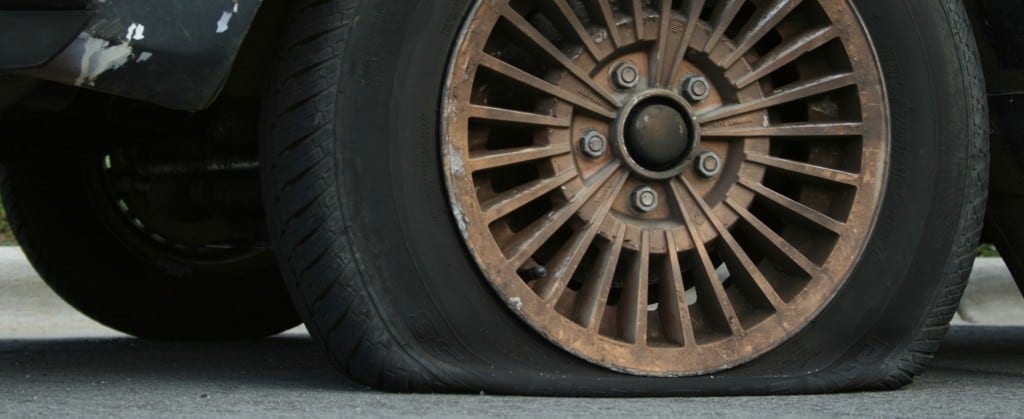When frantically searching for auto service in Albany, NY because you popped a flat, just remember there was something you could have done to prevent that. Am I saying you should have had the knowledge to fix your own tire, and put in the time and effort to do so? No, but the signs that the tires on your car need to be replaced are glaring and the only possible way to avoid looking at your tires is with deliberate negligence. With how easy it is to check them, you should be glancing at them at least once a day — especially if they are getting old. Even a quick glance in the morning can help identify an issue, and prevent an even bigger one from happening later on down the road.
The reason the tires are getting worse isn’t your fault — unless your one of those constant curb-hoppers in the mall parking lot — they simply just wear down over time like every other part on your car. Here’s five warning signs that it might be time for some new tires.
Cracks in the Sidewall
This is the easiest issue to identify when inspecting your tires, even more so than issues that deal with the tread. Why? Because, the side of your tire is one of the first things you see on your car when walking towards it to go to work in the morning. Therefore, a quick visual check isn’t outside the bounds of reality, and will prove to be beneficial.
Now, it’s important to distinguish the difference between serious cracks in the sidewall and non-threatening cracks. The non-threatening “cracks” you see, might not even be cracks at all. If you need to go down there with a magnifying glass to see some slight cracks, don’t bother. The ones you need to look out for are the ones that are visible to the naked eye from a distance, and that look like deep cuts. Any deep cracks or cuts like this indicate that your tire could (potentially) be developing a leak. Or, if there are a lot of deep cuts or cracks, you might be worse off than you thought because your tire could be getting ready to blow.
Therefore, if the cracks look serious, get it into a repair shop and have it inspected pronto. Even if it’s just one tire you noticed, make sure a trained eye takes a look at the other three just in case.
Bulges or Blisters
Bulges and blisters on the tire are also easy to identify, and indicate the potential for a serious problem as well. Overtime, the surface of the tire will weaken. When this happens, a bulge or blister might begin to appear. This bulge or blister is easy to recognize, seeing as it’s a spot on the tire that sticks out compared to the rest of it. Since that spot is weakened, it can’t handle the air-pressure as well, resulting in this bump; and eventually, a potential blow out.
If not noticed and evaluated by a trained mechanic, this bulge could cause your tire to blow out while driving. The built-up pressure exploding out of that weakened area will render the tire useless — and make your driving situation dangerous.
Tread Depth
The tread on your tires is important, and impacts more than you might realize. For example, regardless of driving conditions or the season, the tread has a direct influence on how well your vehicle stops. Or, it can also alter how well your vehicle handles during hazardous conditions. Without the right amount of tread, you put yourself (and others around you) at risk. For a visual, think of the tread like the grip on your shoes. Imagine sliding across a wooden floor with your shoes on. You will stop almost instantly, right? Now, try sliding across it with just your socks on, and I guarantee you’ll slide uncontrollably into your mother’s or wife’s cabinet filled with expensive china dishes.
The “socks” of your tires lie just below the tread. Without that tread, your car will have a harder time stopping, which is why the depth of your tire tread should never fall below 1/16 of an inch. Keep in mind that’s the absolute bare minimum your tread should be reduced to, and if you drive in hazardous conditions you’ll want at least double that. In order to measure the tread, you can buy a gauge like the mechanics at your garage use, or use this simple household trick that’s been around for ages.
The penny test. Simply take a penny and stick it in with Abe’s head upside down and facing you. If you can see all of Abe’s head, the tread is less-than the expert recommended 2/32 of an inch, you need some new tires desperately.
Important to note: just like seeing the tread wear indicator bar, the penny test is only helpful for measuring a tire at the end of its life. Therefore, if you see the tread wear indicator bar, or considering how much of Abe’s head is exposed, you need some new tires stat.
Tread Wear Indicator Bar
This is something that only newer tires are able to take advantage of, and it’s the tread wear indicator bar. As the tread wears down, these bars start to become visible. When in new or like-new conditions, these bars are practically invisible. They run around the center of your tire and are perpendicular to the tread. They are really hard to miss when your tread gets low, and seeing more than one or two of these bars is a sure sign that your tread is getting dangerously low.
Check with your mechanic if these bars become prominent and see how much it will cost to get your tires replaced.
Vibrations in the Tires
Finally, a fifth sign that you need new tires might be vibration. While driving on bad roads is bound to create some vibration, it shouldn’t be glaringly obvious on smoothly paved roads. There could be a number of reasons for this road vibration, such as tires not being properly aligned, shocks starting to go, or a ball joint issue. It can also, however, indicate a problem that lies inside the tire itself. Even if the tire isn’t the root cause of vibration, too much vibration, for whatever reason, will eventually weaken or damage your tire, and is a sign of a serious problem. Have a mechanic look at your car and determine the source.
As a parting thought, remember that if you do need to have a tire replaced, always make sure to swap out the corresponding tire on the other side. Or, have all the tires swapped out. And whether you have two or four swapped out, always get them aligned so your vehicle will negotiate the road properly.







